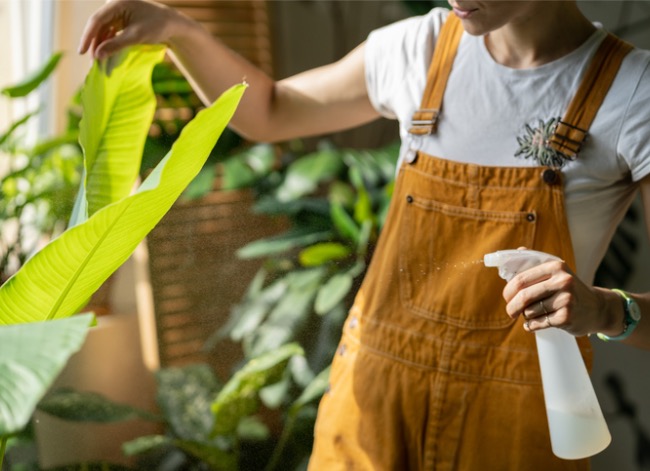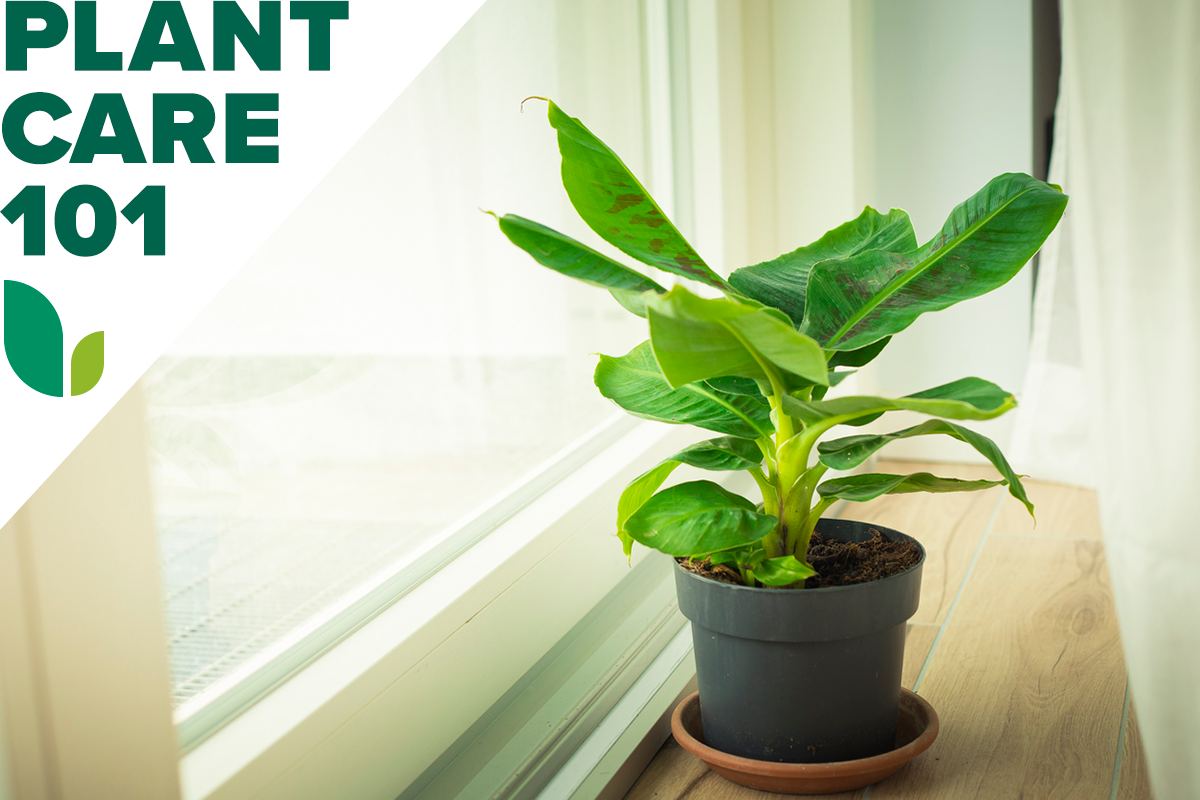We may earn revenue from the products available on this page and participate in affiliate programs. Learn More ›
Banana plants are native to Asia, Africa, and Australia, but they are grown in 135 countries around the world for their fruit. In North America, they can grow outdoors in USDA hardiness zones 9 through 11. However, even people living in cooler climates can grow banana leaf plants indoors—though they may not produce fruit. Banana plants are relatively simple to grow as houseplants so long as their care requirements are met.
Read on for everything you need to know about banana plant care, including the plant’s soil, light, water, and temperature needs.
Banana Plant Care at a Glance
Common Name: Banana plant
Scientific Name: Musa
Soil: Loamy, well-draining, acidic
Light: Full sun
Water: Maintain moist soil
Food: Fertilize weekly during the growing season
Temperature and Humidity: 80 to 89 degrees Fahrenheit, high humidity
Propagation: Propagate from suckers
Safety: Nontoxic
Banana Tree Characteristics
While these plants are often referred to as banana trees, the term “tree” is technically incorrect since the plants have fleshy stalks instead of woody stems. Scientifically speaking, they’re categorized as large herbaceous plants. The stems can grow up to 30 feet long in ideal outdoor conditions.
When grown in the wild, the banana plant produces white, purple, or orange blooms in the spring and develops fruit shortly afterward. When grown as a houseplant, however, it’s rare for the plant to actually produce fruit.
Related: 15 Secret Ingredients to Make Your Garden Grow
Types of Banana Plant
There are many banana plant varieties, but these are some of the most common.
- Dwarf Cavendish bananas (Musa acuminata) are the common variety with which most people are familiar.
- Plantains (Musa x paradisiaca) are a member of the banana family. While they may look like bananas, they’re categorized as vegetables rather than fruits.
- Hardy bananas (Musa basjoo) are popularly grown around the world because of their resistance to dramatic temperature swings.
- Red tiger bananas (Musa sikkimensis) are easy to grow and thrive in shadier locations than Cavendish bananas.
- Goldfinger bananas (Musa Goldfinger) have been bred to be more disease- and pest-resistant than standard bananas.
Selecting Soil for Banana Plants
Knowing how to care for a banana plant begins with the right soil. Since banana plants need plenty of water but can suffer from root rot, it’s essential to choose a well-draining soil with ingredients like perlite to help with aeration.
Ideally, a banana plant’s soil should have a slightly acidic pH of between 5.5 and 7.0, so consider adding a soil modifier if necessary. Choose a potting soil mix high in organic matter, because this will help the nutrients release slowly over time to consistently feed the plant as it grows.
Banana plants develop deep root systems, so even smaller varieties need to be planted in large pots to give the roots plenty of room to grow. Choose a container with several drainage holes to ensure water can drain easily from the soil. A banana tree should be annually repotted in a new pot 2 to 3 inches larger than the one in which it currently grows.
Related: 14 Symptoms of an Unhappy Houseplant (and How You Can Treat Them)
The Right Light
While some banana plant varieties can thrive indoors, they still require plenty of natural light. In fact, most types of banana tree need at least 12 hours of direct sunlight per day, which can be tricky to achieve in many indoor spaces. It’s possible to supplement natural light with artificial grow lights if necessary. When temperatures are warm (above 80 degrees Fahrenheit), giving banana plants a bit of time outdoors in direct natural light is ideal.
If attempting to encourage indoor banana plants to produce fruit, ensure they get as much light as possible. They may begin to flower after 3 or 4 years, which is a sign that they could eventually grow fruit.

Watering Indoor Banana Trees
Banana plants need plenty of water, especially when grown indoors. They’re particularly sensitive to drought, and their soil should be kept moist at all times. It’s easy to tell when banana plants are under-watered because their large leaves will droop and wilt.
Be careful not to overwater banana plants, however, as they can experience root rot if their rhizomes are left in standing water. For the best results, water the plant deeply and allow the water to run through. Avoid letting any water sit in the saucer.
Fertilizing Banana Plants
Banana plants require frequent fertilization during their growing period, which typically takes place between spring and fall. During this time, it’s best to feed them weekly with a well-balanced water-soluble fertilizer. Each fertilizer carries an NPK ratio representing its balance of nitrogen (N), phosphorus (P), and potassium (K). Look for a fertilizer with an NPK rating of 10-10-10 or similar.
As with many plants, banana trees can easily become over-fertilized. One of the primary signs of overfertilization is burnt leaf tips. It’s best to dilute fertilizer to 50 percent to avoid inadvertent over-fertilization.
Setting the Temperature and Humidity
Since banana trees originate in a tropical rainforest environment, they thrive in hot and humid conditions. They do best when daytime temperatures are between 80 and 89 degrees Fahrenheit and nighttime temperatures are at least 67 degrees Fahrenheit. Feel free to bring banana plants outdoors during the warmer months if temperatures consistently land within this range. Be mindful, however, that these plants don’t tolerate high winds, so it’s best to keep them in a covered or protected area.
Home gardeners can also spritz the leaves of a banana tree daily with room temperature water to meet the plant’s humidity requirements. Banana plants’ large, flat leaves have a tendency to accumulate dust, so it’s best to periodically wipe them down with a damp lint-free cloth.

Propagating Indoor Banana Trees
Banana plants frequently develop offshoots—or pups—from the rhizome, which are referred to as “suckers.” These shoots grow alongside the primary stem and should be pruned to maintain the health of the primary plant. Luckily, they also separate easily for propagation.
Simply dig up the rhizome and use a clean sharp knife to separate the sucker from the primary stem. Ensure the sucker has developed its own roots before dividing it, since this will ensure it’s mature enough to be cultivated. Replant the sucker in an appropriately sized container after allowing the rhizome to dry out for 48 hours.

Safety Considerations
All parts of the banana plant are nontoxic to both humans and household pets. They are an excellent indoor plant choice for pet owners, since many common houseplants are potentially toxic if consumed by cats and dogs. This also means they aren’t dangerous in households with young children. The leaves of a banana plant are actually edible—just like the fruit—and are commonly used in cooking worldwide.
Potential Pests and Diseases
One of the primary pests outdoor banana plants attract are banana weevils (Cosmopolites sordidus), which also go by the name of banana root borers. They harm the plant by boring through the stem and rhizome. Luckily, though, weevils are unlikely to infest an indoor banana plant. To be safe, always remove any bugs that appear on any part of the plant.
If conditions are too dry, banana plants also can attract red spider mites.
Related: The 12 Hottest Houseplants for Your Home Office, According to the Masses
FAQs About Banana Plant Care
While you’ve learned more about banana tree care, you still might have some questions about its maintenance needs. Here are some common questions and answers.
Q: Can I grow a banana tree from a banana?
No, it’s not possible to grow a banana tree from a banana. They must be grown from seed.
Q: How long does it take to grow a banana tree?
Banana trees take 2 to 3 years to grow to maturity.
Q: What is the seed for a banana tree?
Commercially grown bananas are bred to be seedless, though it’s possible to purchase seeds from a reputable retailer and follow their instructions on how to grow a banana plant from seed.
Q: Do banana trees come back every year?
When grown outdoors, banana trees are perennial if cared for properly.
Q: When should you plant banana trees?
Banana trees should be planted in spring, but this is less crucial when they’re grown indoors.
Q: Are banana plants poisonous to dogs?
No, banana trees are not toxic to dogs.
Q: Are banana trees toxic to cats?
No, no part of the banana plant is toxic to cats.
Looking for more tropical houseplants? Check out our guides on caring for birds of paradise, money trees, and goldfish plants.


